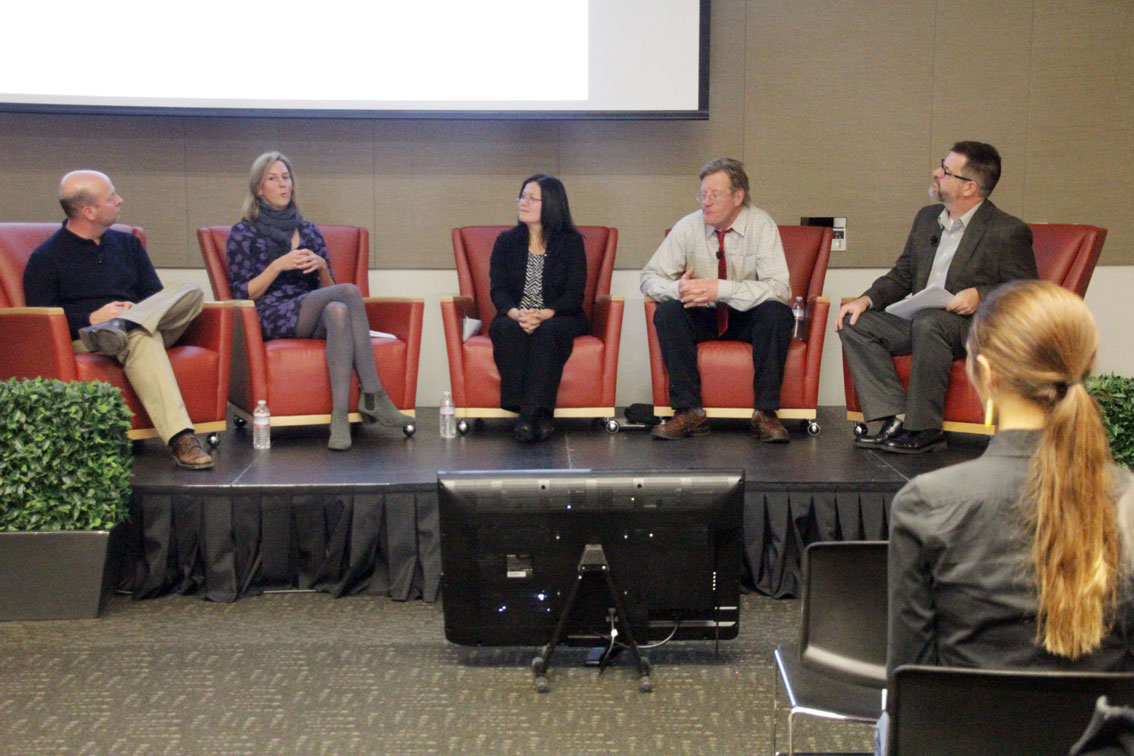
The Bill Lane Center for the American West, Stanford University
2014 Knight-Risser Prize Symposium
New Technologies Bolster Shoe-Leather Journalism
John S. Knight Fellowships
Journalists who are curious and determined are still the key to investigative stories that expose wrongdoing and hidden problems. But new technologies can help lower the costs that discourage media investment. And social media can strengthen and lengthen an investigation’s impact.
At the Knight-Risser Prize Symposium at Stanford, a panel of journalists and experts discussed the current opportunities and challenges for investigative environmental journalism. The $5,000 prize for the best in western environmental journalism is awarded at the annual symposium.
Pulitzer-winning environmental journalist James V. Risser, for whom the award is named, presented the 2013 prize to Tom Knudson of the Sacramento Bee. Knudson, also a Pulitzer winner, won the Knight-Risser Prize for his 2012 series, “The Killing Agency.”
Shedding Light on a Little-Known Agency
Knudson’s series showed a federal agency in overdrive in its duty to protect livestock on ranches and farms in the American West. Knudson documented “predator control” efforts that were brutal, poorly controlled and resulted in the deaths of far more animals than suspect coyotes.
Snares, leg traps. sodium cyanide poison and other killing methods also caught non-target species (included federally protected ones) and family pets. Knudson even found a former trapper for the U.S. Wildlife Services who said he was told not to report accidental deaths of dogs because it would hurt agency funding. Instead, the trapper buried dogs killed by traps, snares and poison and threw the collars away. Knudson also traced efforts to reform the agency back to 1931 – all unsuccessful.
With many traditional news organizations cash-strapped and cutting back on investigative projects, Knudson considers himself lucky his editors gave him about a year to work on the project. As he tracked down new leads and documents, he passed information along to his editors, keeping them up to date on his progress.
Few media organizations today are willing to let reporters spend that much time on one story, said James T. Hamilton, director of the Journalism Program at Stanford and a leader in the field of computational journalism. The panel, moderated by Stanford environmental journalism lecturer Thomas Hayden, also included Ngoc Nguyen, Health and Environment Reporter/Editor for New America Media and Susanne Rust, Environment Reporter for the Center for Investigative Reporting.

Panelists at the Knight-Risser Prize Symposium, from left to right, were James T. Hamilton, Susanne Rust, Ngoc Nguyen and Knight-Risser prize winner Tom Knudson. On the far right is moderator Tom Hayden.
Traditional media is underinvesting in investigative journalism – because it's hard to see the link with revenues, Hamilton said. There are no inherent “eyeballs or advertisers.” One six-month project at a McClatchy newspaper cost $200,000, he said. Most large newspapers can “do two or three (investigations) a year – if they’re fortunate,” he said.
Universities can help by finding ways to make newsgathering and data analysis more efficient and less costly, he said. A turning point in Knudson’s project was finding an agency document listing each animal death in the predator control program from 2000 to 2012. But the data had to be painstakingly transferred to a spreadsheet before it could be analyzed.
Stanford, for its part, is focusing more on data journalism in its masters’ program, Hamilton said. Its goal is to become an educational and research leader in the field.
In the fall, Stanford’s Journalism Program will launch a computational journalism lab that will develop data analysis and visualization tools to help discover and tell public affairs, accountability and investigative stories more efficiently. The lab and new curriculum will focus on the intersection of journalism, data, and new forms of digital storytelling.
Keeping the Story Alive on Twitter
Social media can also boost the power of investigative journalism by carrying stories past their publication shelf life and beyond a core audience. And it can widen the time window for making a difference. Knudson’s stories appeared last spring. While the Bee continues to publish significant developments, Knudson has kept the issue alive every week with new documents and other information posted on social media. Started just a year ago, Knudson’s Twitter account, @tomsplace, now has 839 followers who share news and sound the drum for reform.
Another trend advancing investigative journalism is the aggregation of reporting power, according to Rust and Nguyen. The Center for Investigative Journalism has broadened its capabilities, reach and impact through reporting and distribution partnerships with other organizations. New America Media, a collaboration of 3,000 ethnic news organizations, is experimenting with ways to make better use of its distributed network of journalists.
Different collaborative models have evolved out of different projects, said Nguyen, NAM health and environment reporter/editor. In a current project, the nonprofit Investigative Reporters & Editors organization is helping them crunch data. The results will be sent out to media partners for further reporting. NAM also offers a fellowship program for reporters to work on a project. That’s resulted in a cohort of reporters with strong health and environment reporting skills. “I would love to get them together to report on one story,” she said.
Complete Video of the Symposium Panel (Story continues below)
Stories Don't Always Come from "Deep Throat" Type Insiders
Journalists, alone or in teams, doggedly searching for documenting records and human confirmation have lead to award-winning, sometimes game-changing investigative reports. Occasionally, an investigation is prompted by Deep Throat information, but more often the trigger is simply a journalists’ own curiosity – or a rumor, said Knudson.
For Nguyen, it was whispers that many of the servicemen affected by Agent Orange in Vietnam were Vietnamese Americans and Vietnamese who had fought with U.S. troops. But it took her a long time to find any subjects. People in that community are reluctant to admit they are sick, she said. She put ads in the media seeking sources. She attended veterans support group meetings. When she began hanging out in chemotherapy wards where there were lots of veterans, she finally found her sources.
Knudson had been hearing rumors over the years about family pets and other unintended targets of the U.S. Wildlife Services’ predator control program, which operates throughout the American West.
The agency provided little information and declined his requests to observe trappers in the field. “It’s quite ironic,” Knudson said. “You can go into Iraq … the military will take you in. But in the U.S., you can’t go on public land with a federal agency to see what they do?”
His frustration fueled his efforts to find former employees. He also filed 75 requests for documents under the Freedom of Information Act law, and dug through decades-old government reports and hearings and peer-reviewed literature on the topic. He learned that scientists had been raising concerns over the agency’s “waste and inefficiency” since 1931. In fact, the deaths of so many wild animals could actually harm the ecosystem, the American Society of Mammologists wrote to federal officials. There were other letters over the years, as recent as 2012. Yet efforts at reform failed over and over again, Knudson found.
And a list of each animal killed by the agency – a gem found tucked in its own website – confirmed, once it was analyzed, what he had been hearing. Leg traps, snares and other brutal killing methods targeting coyotes had swept in family pets along with other species, including protected eagles.
The data showed that 1,232 “wild” or “feral” dogs were killed between 2000 and 2012. Knudson found many were actually family pets by tracking down the cases down. One was a dog being walked by his owner on public land. When the owner looked away for a few minutes, her dog tugged on a snare with a spring-loaded poison cartridge. She watched it die, Knudson said. And he found a former agency employee who said trappers were told not to report dogs killed in agency traps because it would hurt funding. They buried the dogs and threw the collars away.
Still, the revelations weren’t enough to change agency practices. Two congressmen proposed reform legislation last year, but have been unable to get it heard in committee.
But Knudson said he won’t abandon the story. “I don’t want to see that same report from the Society of Mammologists in another 100 years.”
Nguyen noted that change often begins at the grassroots level. “ I was covering workplace hazards a number of years ago. It wasn’t the feds who prompted change; it was due to consumer pressure.
“You might want to think about creating that change from the bottom up,” she encouraged Knudson, “with social media.”
Complete Audio: Knight-Risser Symposium Panel, Feb. 5, 2014
Duration: 49 minutes (download as podcast)
For More Information
Read the 2013 Knight-Risser Prize winning story, "A Killing Agency" and learn more about the winner, Tom Knudson of the Sacramento Bee.
Knight-Risser Prize Symposiums:
“When the Well Runs Dry: Confronting a Groundwater Crisis” 

January 2017 Knight-Risser Prize Symposium, January 25, 2017
“Breathless in Texas: Energy Production Puts Air at Risk” 

2016 Knight-Risser Prize Symposium, February 17, 2016
“Troubled Waters: Marine Life and the Threat of Ocean Acidification” 

2015 Knight-Risser Prize Symposium, February 25, 2015
“Deadly Measures: Uncovering a Little-Known Agency's Toll on Wildlife” 

2014 Knight-Risser Prize Symposium, February 5, 2014
“Wildlife, Wired: How Technology Is Changing Nature Reporting” 

2013 Knight-Risser Prize Symposium, February 20, 2013
“Adapting to Dry Times: The Role of the Media in an Increasingly Arid West ” 

2012 Knight-Risser Prize Symposium, January 25, 2012
“The Crisis in Western Environmental Journalism” 
November 2010 Knight-Risser Prize Symposium, November 17, 2010
“Visualizing the Environment” 
January 2010 Risser Prize Symposium, January 27, 2010
“Climate Change Hits Home”
December 2008 Risser Prize Symposium, December 3, 2008
“Environmental Fallout of the Cold War” 
March 2008 Risser Prize Symposium, March 13, 2008
“Water in the West: 21st Century Challenges in a 19th Century Legal Framework” 
2005 Risser Prize Symposium, November 1, 2005
A list of each animal killed by the agency — a gem found tucked in its own website — confirmed what Knudson had been hearing. Leg traps, chemical snares and other brutal killing methods targeting coyotes had swept in family pets along with other species, including protected eagles.


Traditional media is underinvesting in investigative journalism – because it's hard to see the link with revenues, Hamilton said. There are no inherent “eyeballs or advertisers.” Most large newspapers can “do two or three (investigations) a year – if they’re fortunate,” he said. ”
Texas Tribune, ProPublica

The Desert Sun and USA Today

CPI, InsideClimate News, The Weather Channel

The Seattle Times

The Sacramento Bee

High Country News

5280 Magazine

Seattle Post-Intelligencer

What Went Wrong?
The Seattle Times

San Antonio Express-News

The Los Angeles Times

High Country News





